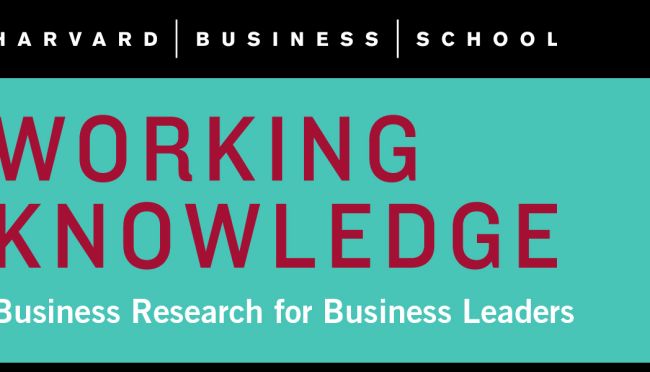Networks →
→

- 23 Jun 2023
- HBS Case
This Company Lets Employees Take Charge—Even with Life and Death Decisions
Dutch home health care organization Buurtzorg avoids middle management positions and instead empowers its nurses to care for patients as they see fit. Tatiana Sandino and Ethan Bernstein explore how removing organizational layers and allowing employees to make decisions can boost performance.

- 15 Sep 2022
- Research & Ideas
Looking For a Job? Some LinkedIn Connections Matter More Than Others
Debating whether to connect on LinkedIn with that more senior executive you met at that conference? You should, says new research about professional networks by Iavor Bojinov and colleagues. That person just might help you land your next job.

- 30 Oct 2018
- Working Paper Summaries
Design Rules, Volume 2: How Technology Shapes Organizations: Chapter 5 Complementarity
Even as economics has theories about what assets and activities should be grouped together under common ownership and unified governance, in practice it sometimes makes sense to distribute complementary assets, skills, and activities across separate organizations. This paper investigates when and how this happens.
- 07 Sep 2016
- What Do You Think?
How Can the Threat of Networks Be Reduced?
SUMMING UP Are ever-expanding technology networks a threat to business leadership? Jim Heskett's readers are largely doubtful. What do YOU think? Open for comment; 0 Comments.
- 10 Sep 2014
- Research & Ideas
Become a Value Creator
Managers who adopt a mindset to create value hold the key to becoming truly successful leaders, says Brian Hall. Closed for comment; 0 Comments.
- 25 Oct 2012
- Research & Ideas
Developing the Global Leader
The shift from a country-centric company to one more global in its outlook will have a radical impact on leadership development, says Professor of Management Practice William George. Closed for comment; 0 Comments.
- 16 Apr 2012
- Research & Ideas
The Inner Workings of Corporate Headquarters
Analyzing the e-mails of some 30,000 workers, Professor Toby E. Stuart and colleague Adam M. Kleinbaum dissected the communication networks of HQ staffers at a large, multidivisional company to get a better understanding of what a corporate headquarters does, and why it does it. Closed for comment; 0 Comments.
- 20 Jul 2009
- Research & Ideas
Markets or Communities? The Best Ways to Manage Outside Innovation
No one organization can monopolize knowledge in any given field. That's why modern companies must develop a new expertise: the ability to attract novel solutions to difficult or unanticipated problems from outside sources around the world. A conversation with Harvard Business School professor Karim R. Lakhani on the keys to managing distributed innovation. Key concepts include: Many organizations find they cannot monopolize knowledge in any given field of endeavor. Firms need to consider three key factors in deciding to pursue either a community- or market-based external innovation model. Successful models developed by Apple, InnoCentive, SAP, and TopCoder create incentives for many entrants to generate a variety of products and services on a platform. The firm's role is to define the boundaries of the platform and then encourage entry and innovation by outsiders. Closed for comment; 0 Comments.
- 22 Sep 2008
- Research & Ideas
The Silo Lives! Analyzing Coordination and Communication in Multiunit Companies
A new Harvard Business School working paper looks inside the communications "black box" of a large company to understand who talks to whom, and finds the corporate silo as impenetrable as ever. Q&A with professor Toby E. Stuart. Key concepts include: Inside the studied company, practically speaking, little interaction occurred across three major corporate boundaries: business units, organizational functions, and office locations. Communication patterns were extremely hierarchical: Executives, middle managers, and rank-and-file employees communicated extensively within their own levels, but there were far fewer cross-pay-grade interactions in the firm. Junior executives, women, and members of the salesforce were the key actors in bridging the silos. Relative to men, women participate in a greater volume of electronic and face-to-face interactions and do so with a larger and more diverse set of communication partners. Server logs can provide valuable information to managers on communication flows within their own organizations. Closed for comment; 0 Comments.

- 31 Jul 2008
- Working Paper Summaries
Communication (and Coordination?) in a Modern, Complex Organization
Coordination, and the communication it implies, is central to the very existence of organizations. Despite their fundamental role in the purpose of organizations, scholars have little understanding of actual interaction patterns in modern, complex, multiunit firms. To open the proverbial "black box" and begin to reveal the internal wiring of the firm, this paper presents a detailed, descriptive analysis of the network of communications among members of a large, structurally, functionally, geographically, and strategically diverse firm. The full data set comprises more than 100 million electronic mail messages and over 60 million electronic calendar entries for a sample of more 30,000 employees over a three-month period in 2006. Key concepts include: Communication is heavily constrained by formal organizational structure: the vast majority of communication occurs within business unit and functional boundaries, not across them. This points to the importance of drawing the right organizational boundaries. Women, mid- to high-level executives, and members of the executive management, sales, and marketing functions are most likely to participate in cross-group communications. These individuals provide a bridge for distant groups in a company's social structure. Closed for comment; 0 Comments.
- 23 Jul 2007
- Research & Ideas
HBS Cases: How Wikipedia Works (or Doesn’t)
For HBS professor Andrew McAfee, Wikipedia is a surprisingly high-quality product. But when his concept of "Enterprise 2.0" turned up on the online encyclopedia one day—and was recommended for deletion—McAfee and colleague Karim R. Lakhani knew they had the makings of an insightful case study on collaboration and governance in the digital world. Key concepts include: Despite thousands of participants, Wikipedia operates under a very ornate and well-defined structure of participation that enables them to produce a highly regarded online encyclopedia. A group of people in the Wikipedia world characterized as "exclusionists" could dampen user enthusiasm by increasing barriers to acceptance of Wikipedia articles. Knowledge-sharing technologies such as wikis are coming into increasing use in the corporate world, but companies must understand that a top-down approach to administering them will lead to certain extinction. Closed for comment; 0 Comments.
- 08 Mar 2004
- Research & Ideas
Creating Value in Your Business Ecosystem
The metaphors of keystones and ecology help you think about your business environment, say professor Marco Iansiti and consultant Roy Levien. A Harvard Business Review excerpt. Closed for comment; 0 Comments.
- 23 Jun 2003
- Research & Ideas
Building a Better Buyer-Seller Relationship
How do you turn short-term transactions into long-term relationships? Harvard Business School professor Narakesari Narayandas finds answers in mature industrial markets. Closed for comment; 0 Comments.

The Network Effect: Why Companies Should Care About Employees’ LinkedIn Connections
What do Honeywell, IBM, and Pfizer have in common? Employees with strong professional networks. A study of 2 billion employee relationships on LinkedIn probes the power of such connections—and potential benefits for companies. Research by Frank Nagle.